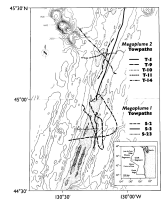
U.S. Dept. of Commerce / NOAA / OAR / PMEL / Publications
The Cleft Segment (also known as the Southern Symmetrical Segment or rift A) of the JDFR is a 55-km-long dome bounded on the south by the Blanco Fracture Zone and on the north by the Vance Segment, which is offset 5 km to the west at 45°N (Figure 1). Descriptions of the morphology of this segment by Kappel and Ryan [1986] emphasize the ubiquity of recent volcanic flows and constructional features. Throughout most of its length the axial valley of the Cleft Segment is a 2- to 3-km-wide linear feature enclosed by valley walls of 80-120 m relief. South of 44°42′N the floor of the axial valley has a smooth-textured surface of high acoustical reflectivity that is split by a remarkably continuous central cleft. The cleft is presumably the source of the voluminous and evidently fluid volcanic flows that presently cover the unsedimented valley floor [Kappel and Ryan, 1986]. From 44°42′N to 44°49′N the valley floor becomes a disrupted surface broken by faults and volcanic constructions. The largest volcanic cone is 60 m in height, though most have only 20 to 40 m of relief. North of 44°50′N the central volcanic cones give way to a nearly continuous steep-sided depression. The eastern wall correspondingly fades into a linear depression. The disappearance of the eastern wall is accompanied by a distinct eastward bulge in the depth contours on the flank of the ridge crest.
Figure 1. Bathymetry of the Cleft and Vance segments on the Juan de Fuca Ridge. Tracks of the CTD tows used to define megaplume 1 (at ~44°50′N) and megaplume 2 (at ~45°15′N) are also shown.
Two primary centers of hydrothermal activity are present on the Cleft Segment. The most studied area, a chain of vent fields distributed along a 5-km section centered on the axial high at ~44°40′N, was discovered in 1981 [Normark et al., 1983] and sampled by a submersible Alvin in 1984 [U.S. Geological Survey Juan de Fuca Study Group, 1986] and 1987 [Embley et al., 1988]. Since 1981, annual surface ship sampling and CTD/transmissometer tows [Massoth et al., 1982, 1983; Baker et al., 1985; Baker and Massoth, 1986a, 1987] have demonstrated an apparently continuous emission of hydrothermal fluids from this vent field. A much more extensive hydrothermal plume was discovered in 1986 [Baker and Massoth, 1986b; Baker et al., 1987] at the northern end of the Cleft Segment. The first megaplume was found above this vent field [Baker et al., 1987].
Go back to previous section or forward to next section